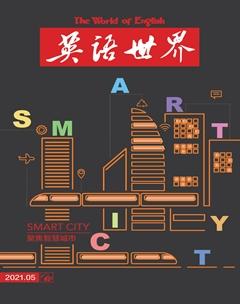Art Is How We Justify Our Existence艺术是人类存在的理由
大卫·卓纳
Our technologies are tools. But our creative works carry the wisdom of the world. 科技是工具,而富有創造力的作品则是人类智慧的体现。
When I agreed to write this essay, little did I know that when I finally sat down to tackle it all my favorite museums would be closed to the public, along with every library, theater, concert hall and movie house and, of course, the galleries I own. Its a bit like our world faded abruptly and unexpectedly from vivid color to black and white.
But it dawned on me that there could hardly be a better moment to reflect upon the importance of art—or, better still, culture itself—than in the face of its almost complete physical absence.
Art is not something that happens at the periphery of our lives. Its actually the thing thats right there in the center, a veritable1 engine. Its like my mother once said: “Die Kunst ist unsere Daseinsberechtigung.2” Art is how we justify our existence.
Weve been creating art for much longer than recorded history. The earliest surviving visual art, as in the cave paintings of Sulawesi in Indonesia and El Castillo3 in Spain, date back to roughly 40,000 years ago. I have to assume theres earlier work that we dont yet know about. Our great rivals in the evolutionary race, the Neanderthals4, were stronger, bigger and had larger skulls than us, but left behind no sophisticated tools and very little in the way of artifacts. One argument holds that the Neanderthal imagination was limited, and that Homo sapiens5 more complex and adventurous way of thinking—our creativity—is what moved us to the forefront among the human species.
For me, art is not just sensory stimulation. I believe its most gratifying as an intellectual pursuit. Great art is, by definition6, complex, and it expects work from us when we engage with it. There is this wonderful moment, one that I have missed so much lately, when you stand before a work of art and, suddenly, the work is speaking back to you. Great works carry with them so many messages and meanings. And often those messages survive for centuries. Or—even more mysteriously—they change as the years and decades pass, leaving their power and import somehow undiminished.
Velázquez7s “Las Meninas”8 comes to mind, as does the intense pleasure Ive experienced every time Ive seen it, at different stages of my life, at the Prado museum9 in Madrid. Thinking about “Las Meninas” today, amid the new reality of a pandemic, reminds me how much I look forward to seeing works of art in their physical spaces again. There is no substitute for the artworks materiality, which ultimately and invariably relates to our senses, our bodies and our analyt-ical prowess and intellectual curiosity.
The appreciation of art is, more often than not, a communal experience. It brings us together—when we go to museums, to openings, to concerts, to movies or to the ballet or theater. And we argue, and sometimes we fight, but we certainly dont wage war over artistic expression. I would contend that art and culture are the most important vehicles by which we come to understand one another. They make us curious about that which is different or unfamiliar, and ultimately allow us to accept it, even embrace it.
Lately, a discussion has raged about how art and culture stack up against10 the hard sciences. More ominously, the question is weighing on11 the colleges and universities of the United States, where the humanities are playing an ever smaller role. Thats a dangerous proposition. While the sciences have brought into this world so many wonderful things, they are also implicated12 when it comes to our most sinister achievements—nuclear warfare, genetic manipulation and the degradation of nature.
While art can reach into the darkest places of the human psyche, it does so to help us understand and hopefully transcend13. Art lifts us up. In the end, I think its mission is simply to make us better people.
The machines have proven to be absolutely amazing during a pandemic, connecting us, informing us and entertaining us, but in the end they are limited. Theyre born of science and they have no imaginations. We have to imagine for them.
If we Homo sapiens are challenged again, it will not be by the Neanderthal—nor by any other species—but by the machines we invented ourselves. Winning that battle cant be done without firing up the most important engines we possess—culture and creativity—because reason is born out of our cultural experiences. Works of art carry with them the wisdom of the world. ■
應允写这篇文章时,我并不知道自己终于坐下动笔之际,所有我最喜爱的博物馆,连同图书馆、剧院、音乐厅还有电影院,会全部停止对外开放。当然,我自己的那些画廊也一样。这有点像整个世界突然之间就褪去鲜艳色彩,只剩下黑白,没有任何征兆。
但我慢慢意识到,恰恰是几乎完全无缘欣赏实体艺术的当下,最适合认真思考艺术的重要性(思考文化的重要性就更恰逢其会了)。
艺术在人的一生中并非可有可无,而是位居中心,堪称生命的发动机。正如我母亲曾说:“艺术是我们存在的理由。”艺术是人类存在的理由。
人类创作艺术的时间要远长于有记载的历史。印尼苏拉威西岛和西班牙埃尔卡斯蒂略史前洞穴的壁画是现存最古老的视觉艺术作品,可追溯至大约四万年以前。想必还存在更早的作品,只是我们暂未发现。在人科物种的演化竞赛中,尼安德特人是我们智人的强劲对手,他们更为强壮,体型更大,头骨也更大,但却没有留下复杂的工具,也没什么手工制品。有种观点认为,尼安德特人想象力有限,而智人凭借更为复杂、更具开拓精神的思维方式,即我们所说的创造力,在人类种群中脱颖而出。
对我来说,艺术绝不只是感官刺激。我认为艺术更是对智慧的追求,让人感到无比满足。伟大的艺术本质上是复杂的,我们需要付出努力才能理解。当站在艺术品跟前,突然觉得作品在与自己对话,那个时刻当真妙不可言,我近来分外怀念这种体验。伟大的作品寓意丰富,这些寓意往往历久而不衰。更为奇妙的是,随着岁月流逝,时代更迭,作品的寓意会随之发生改变,而其影响力和重要性却分毫不减。
此刻,我不禁想起委拉斯凯兹的《宫娥》,内心随即产生极度的愉悦,人生的几个不同阶段,我都曾在马德里的普拉多博物馆看这幅画,每次都能体会到这种感觉。如今疫情流行,在新的现实环境下想到这幅画,让我意识到自己多么渴望能再次在场馆内欣赏艺术作品。没有什么能替代艺术品的客观实体,因为欣赏艺术品最终必然需要用到我们的感官、身体、分析能力和求知欲。
艺术欣赏往往是一种群体活动。参观博物馆,出席开幕式,聆听音乐会,上影院观影,观看芭蕾或戏剧演出,我们因艺术齐聚一堂,也就艺术的表达各抒己见,有时还会争辩,但显然不会为此发动战争。我认为,文化艺术是我们得以了解彼此的最重要工具,让我们对不同于自身或不熟悉的存在抱有好奇之心,最终愿意承认,甚而欣然接受这样的事物。
最近,人们就文化艺术与自然科学孰高孰低展开激烈争论。令人倍感沉重的是,这个问题让人文学科影响力本就日渐式微的美国高校饱受压力。这一论题非常危险。科学固然为这个世界创造了许多奇迹,但说到人类活动造成的最邪恶结果——核战、基因操控、自然环境恶化,科学却也难辞其咎。
尽管艺术可以抵达人心最阴暗的角落,它也由此让我们学会理解他人,有望突破自我。艺术让我们提升境界。我认为艺术的最终目的只为让我们变得更好。
机器在疫情期间发挥的巨大作用确实令人赞叹,使人们能够保持联系、获取信息、娱乐放松,但它们毕竟不是万能的。机器是科学的产物,没有想象力。想象只能由人类替它们完成。
如果说我们智人会再次遭遇挑战,挑战不会来自尼安德特人,也不会来自其他物种,只会来自人类自己发明的机器。要想不被机器打败,必须开动我们最为重要的马达,即文化和创造力,因为文化体验能产生理性思考。艺术作品正是人类智慧的体现。 □
(译者单位:南京晓庄学院)
1 veritable不折不扣的;名副其实的。 2此句对应“Art is our raison dêtre.”。
3埃尔卡斯蒂略史前洞穴位于西班牙坎塔布里亚(Cantabria)山中小镇蓬特维耶斯戈(Puente Viesgo)的卡斯蒂略山(Monte Castillo)中。这一带有不少史前洞穴壁画遗址,包括埃尔卡斯蒂略洞穴(El Castillo Cave,又称Cave of the Castle)、拉斯莫奈达斯洞穴(Las Monedas Cave)、拉帕西加洞穴(La Pasiega Cave)等,这些洞穴统称为“卡斯蒂略山洞穴群”(Caves of Monte Castillo)。 4尼安德特人,简称尼人,因其化石发现于德国尼安德特山谷得名,后被智人取代,和智人属于人属下的不同種。 5智人,人属下的唯一现存物种。 6 by definition根据自身特点;从本质上来讲。
7指迭戈·委拉斯凯兹(Diego Velázquez,1599—1660),17世纪巴洛克时期西班牙画家,以画肖像画著称。 8也译《侍女》,为委拉斯凯兹创作的油画。 9普拉多博物馆位于西班牙马德里,是世界上最伟大的博物馆之一,也是收藏西班牙绘画作品最全面、最权威的美术馆。
10 stack up against(和类似事物)相比,比高低。 11 weigh on sb/sth(问题、责任等)使(某人)焦虑不安,使(某人)担忧。 12 implicate牵连,涉及。 13 transcend超越,超出(尤指界限)。
- 英语世界的其它文章
- What Does a Smart City Look Like? 智慧城市什么样?
- Smart City Vs. Normal City: What Are the Differences? 智慧城市与普通城市有何差别?
- A Smart City: More Than Just Tech 智慧城市不止科技
- Smart City: The Top Stories of 2020 2020年智慧城市杰出案例
- How the World Uses Digital Twins to Solidify Smart City Development 数字孪生助力智慧城市建设
- Covid-19 Unlocks the Potential of Smart Cities in China 新冠解锁中国智慧城市潜力

